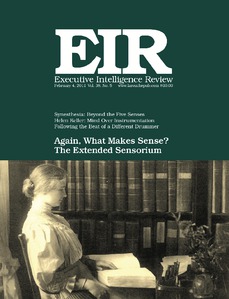The Extended Sensorium
by Lyndon H. LaRouche, Jr.
“In this present report,” Lyndon LaRouche wrote, “our attention is focused on the domain of a middle stage of our obligatory investigations, a stage which is represented by the seeking out of the subject of those additional sensory powers which are expressed within the ranges of cosmic radiation, which now includes what are both useful and tolerable for both human and other forms of life, but are, nonetheless, not yet the voluntary expressions of specifically human creative powers.
“Although these extended powers of sense-perception, include, for example, the special senses expressed as being employed through the design of migratory birds, the extended categories of sense-perceptions, such as those of such birds, do represent an intermediate quality of types, which all share the quality of the intermediate quality lying between what might be regarded as presently accepted notions of sense-perception and the cognitive powers unique to the human species among known species of living organisms. Next, comes creativity in and of itself.
“It is my function in this report, to identify the mission which this indicated set of steps implies, the mission which other members of the team will, chiefly, carry out.”
Synesthesia: Beyond the Five Senses
by Oyang Teng
Oyang Teng demonstrates that, even what we commonly tend to recognize as sense perception, cannot be neatly divided into five distinct categories.
Helen Keller: Mind over Instrumentation
by Meghan Rouillard
In Meghan Rouillard’s case study of Helen Keller, we will begin to see the peculiar relationship between mind and the senses, and see that mind, as a principle, is not, in fact, dependent upon any specific “set” of given senses.
Following the Beat of a Different Drummer
by Peter Martinson
Peter Martinson presents a study of biological rhythms in animals and humans, and discusses the ability of organisms to respond to solar and other extraterrestrial cycles.
Polarization Sensitivity: A Strong and Weak Sense
by Meghan Rouillard
In a more detailed view of the role of electromagnetic phenomena in the Biosphere, Meghan Rouillard describes a sense which might, at first, seem alien to humans: the ability to sense polarized light.
What Is Circularly Polarized Light?
by Jason Ross
Jason Ross describes the characteristics of polarized light.
Insects and Infrared
by Oyang Teng
Oyang Teng’s discussion of insects using infrared emissions as a sense of “smell.”
Magnetoreception
by Benjamin Deniston
Benjamin Deniston’s detailed discussion of the still-puzzling phenomenon of magnetoreception in birds and other animals—their ability to perceive the detailed structure of the Earth’s magnetic field, for use in navigation.
Unheard Melodies: Electric and Magnetic Senses in Humans
by Aaron Halevy
Sky Shields takes up various expressions of the human ability to perceive electromagnetic phenomena, with a specific emphasis on the electromagnetic conditions to be found as humanity migrates poleward, as we implement the proposed North American Water and Power Alliance (NAWAPA).
The Sounds of a Cosmic Chorus
A discussion of Classical musical composition and human culture by Aaron Halevy.
Editorial
The Revolution Is Underway



